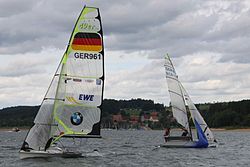This article needs additional citations for verification .(August 2008) |
| Class symbol | |
 | |
| Development | |
|---|---|
| Boat | |
| Crew | 2 (double trapeze) |
| Draft | 1,447 mm (4 ft 9 in) |
| Hull | |
| Hull weight | 94 kg (207 lb) |
| LOA | 4,876 mm (16 ft) |
| Beam | without wings: 1,752 mm (5 ft 9 in) with wings: 2,743 mm (9 ft 0 in) |
| Sails | |
| Spinnaker area | 37.16 m2 (400 sq ft) |
| Upwind sail area | 19.97 m2 (215 sq ft) |
| Racing | |
| D-PN | 68.2 [1] |
| RYA PN | 710 [2] |
| Current Olympic equipment | |
The 49er is a double-handed skiff-type high-performance sailing dinghy. The two crew work on different roles with the helm making many tactical decisions, as well as steering, and the crew doing most of the sail control. Both of the crew are equipped with their own trapeze and sailing is done while cantilevered over the water to the fullest extent to balance against the sails.
Contents
- History
- Construction
- Hull
- Spars
- Foils
- Sails
- Events
- Olympics
- World Championships
- Related boats
- References
- External links
The 49er was designed by Julian Bethwaite (the son of Frank Bethwaite) and developed by a consortium consisting of Bethwaites, Performance Sailcraft Japan, Peter Johnston, and Ovington boats. [3] The boat has been an Olympic class since it was selected by the International Sailing Federation to be the men's high performance double handed dinghy Sydney Summer Games of 2000. Its derivative featuring a re-designed rig, the 49er FX, was selected by World Sailing to be the women's high performance double-hander at the Rio Summer Olympics of 2016.


